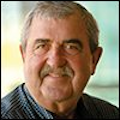Returning to Earth
By Vernon May
Don and I have brought another of our disagreements to conclusion. He has always insisted that the power lines impact broadband service. My position has been that the pure harmonics of 60 Hz have so little power at the DSL frequency range that they have no impact. When compared to the background noise levels from pair-to-pair crosstalk within the binder groups, it’s next to nothing.
In this case, we were both right — kind of. As we discussed what Don saw in the field and what I saw in the field, some factors previously not considered came to light that are significant.
Ghost noise
Penzias and Wilson were Bell Labs radio engineers in 1964 working with a Holmdel horn antenna. You can still see these horn-shaped antennae on the microwave towers; the most common is the KS-15676 C-band.
Like all very sensitive devices, calibration is the key to meaningful results with the horn antenna. The engineers had successfully found radio and radar noise, and found ways to filter out those sources. Still, there was background noise in the microwave band that was literally everywhere. They recalibrated, but the background noise continued. Finally, they were put in touch with some theoretical physicists who were looking for weak microwaves to prove the Big Bang theory. The rest is history.
Current conditions
This happy accident could never happen now. The air is so full of radio and microwaves that even the Big Bang is no longer discernable from the noise.
Throw in every conceivable type of electrical device communicating via every approved wireless band. Most of these devices have to be cooled, so there are more electric motors on the power grid than there ever have been. The compact florescent light bulbs (the curly ones) have cheap and dirty electronic ballasts that have been proven to be a source of impulse noise.
The power distribution grid is not designed to clean up the return signals. They just want all the power at every frequency to go back to the substation.
Now, throw in the fact that our copper cables are in the best possible physical place to receive inductive noise at all frequencies from that power grid. Oh, and let’s not forget that our subscribers’ expectations for bandwidth are at an all-time high.
Our take on noise induced from the power grid
Based on our results, 60 Hz (distribution power) does not create harmonics that impact DSL of any flavor. That said, the noisy energy coming back from the consumer devices to the substation can impact DSL of all flavors. When using a spectrum analyzer, you can see a pattern that overwhelms the pair-to-pair crosstalk noise.
Ideally, we want every unwanted signal that is induced into our cable to go back to the power distribution grid over as short a distance as possible. The old rules about bonding our cable sheaths to Multi-Neutral Ground (MNG) at regular intervals are even more important than ever because the induced returned signals are dirtier than ever.
What about when the power is on one side of the road and our cable is on the other?
I hate to say it, but road bores or aerial ground wires should be in your future. The distance between the 2 sources separated by the road is not enough to protect from inductance. We must put the induced signal back onto their grid with a physical bond to the MNG.
What if we need to fix a customer problem when we know that the entire cable needs bonding and grounding work?
This situation is relatively common. The simplest strategy is to do bond reworks as close to that customer as possible, starting with the NID ground being bonded to the power ground. Physical proximity matters in impulse noise, so protecting closer to the subscriber helps more. We also use a more complicated strategy that depends on impulse noise testing.
Impulse noise test
The most crucial setting when measuring impulse noise is the threshold power. The impulse noise test works this way:
If any frequency in the range under test receives a pulse >= the threshold power = 1 pulse. Put another way, with the threshold at -45 dBm, energy at 850 KHz at a magnitude of -43 dBm = 1 pulse. A magnitude of -46 = no pulse.
We believe a setting of -45 dBm is the best place to start. Then, we test at higher amplitudes to find the peak noise levels.
Our personal preference is to measure impulse noise in decibels when 1 milliwatt = 0 (or dBm). We use dBm in all our noise testing because the consistent 0 setting makes it easier to understand overall impact.
Concerning filters, we believe in matching the technology used by the subscriber. For instance, for an ADSL2+ customer, we use the G2 filter. The point of the filter is to ignore pulses that are not impacting that specific service.
Test duration should be set at 5 minutes. The original recommendation was 60 minutes, but nobody has enough slack time to run 60-minute tests.
Warning! If you test with the modem or DSLAM on the circuit, you will see "ghost" impulse noise hits. You can normally spot this mistake because you will see about 4 pulses per second at high amplitude.
• If we take 0 pulses after 5 minutes at -45 dBm, we test for impulse noise on other connections.
• If there are pulses at -45 dBm, we change the threshold to -35 dBm and count the pulses.
• If the pulses stop, we drop the threshold to -40 dBm and count the pulses.
Note: This is where having multiple thresholds helps reduce test time. One 5-minute test gives you readings at 3 different preset amplitudes.
As a rule of thumb, pulses under -45 dBm don’t impact service. Between -45 and -35 dBm, service could be impacted. Above a -35 dBm, service will be affected negatively. We are looking for the highest amplitude pulses as the initial target. This is consistent with our overall "fix the worst first" strategy.
Noise can never be eliminated. Our goal is to reduce the amplitude of the noise to a level that does not negatively impact service.
All these unwanted signals will find their way back to the source via earth some way. We can’t stop that, but we can put them back where they belong; on to the power grid.
Even though we are using different tests and thresholds in our broadband noise testing than we use with POTS testing, the results are pointing us back to the old POTS bonding and grounding practices to help broadband impulse noise issues. Score another one for the good ol’ days.
Signing off
We enjoy tackling anything copper, including in-depth discussions around DSL, noise, copper-to-fiber transition, and probably anything else you deal with, so please let us know what you want to know about or what challenges you are facing. Text or email Donald at 831.818.3930, [email protected], and Vernon at 254.979.4749, [email protected].
Vernon May is the Technologist at Vernon May Solutions. He has more than 37 years of experience in telecom technology and operations. For more information, please call Vernon at 254.979.4749, email [email protected], or visit www.vmaysolutions.com.
About the Author

